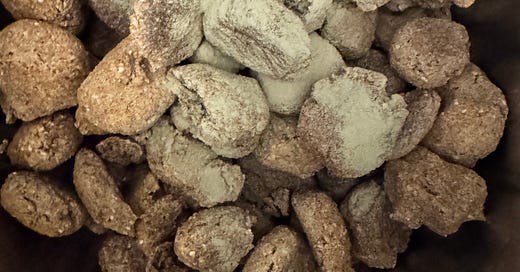When you're making koji, and you're making it for the enzymes that you hope to produce, it doesn't really matter what substrate you use to grow those enzymes on.
For example, if I were going to make an extract of the enzymes to make a shio koji, shoyu, or amasake—all these things—it’s not all that important to have perfect ingredients, because remember: Aspergillus and other filamentous fungi grow naturally in the wild.
One of their major functions is to help decompose dead wood and leaves, and all kinds of plant materials, including cellulose and pectin—all the things plants are made of.
These are the things that create kasu, or dregs, after you strain your sake, for example, or strain your shoyu.
So, I make sourdough starters for many different reasons. One is for baking. Sometimes I let my sourdough starters really sour and use them to make traditional Eastern European soups.
Other times, I’ll let them sour out and use them to ferment pickles of any kind. There are really excellent uses for sourdough starter.
Remember, a sourdough starter typically reduces the phytate levels in grains, and often other hard-to-digest or anti-nutritional components.
My favorite, however, is to accumulate lots of it when I can. And if you want to freeze sourdough starter discard—as it's called—you can do that. You just have to defrost it.
I mill my own rice. In this case, it's a dryland rice. It's grown locally, and I mill it down to 75%. For reference, table rice is usually milled to about 90%.
I make koji dama, or balls, out of my sourdough starter and brans, then bake them for a long time. I don’t want any excess water in there. I also want to kill off most of the bacteria. That may leave a slightly sour taste, but that’s fine.
I removed my rice bran and wheat-based sourdough starter balls or koji dama to be from the oven. They were in there for about 90 minutes at 350°F.
And although they appear very dry, nothing you ever make—even if you're attempting to dry it out—is ever 100% dry. And I would wager that this has about 10–15% moisture.I'm going to use that moisture, because fungus and molds need moisture.
So, in my Instant Pot container, I'm going to put my customary trivet down because you don't ever want anything sitting in condensation or water. And if there are beans involved, you really don't want any excess water.
need the heat for water—because once these are cooled down to 90F —they’ll be covered in condensation. That’s what I want.
I'm going to do that before I actually add my spores to this and inoculate them. I just put about a teaspoon of spores on my balls then shake well.
I have my Instant Pot at 90°F—nine-zero—and put the top on.
The sous vide setting for 48 hours. Take it off after 24 to check the condensation.Typically, when you're doing a really thirsty thing like bran, you won't get much water or have the need to change the clothes, because it’s going back into the koji to feed—or facilitate the feeding of—the mold as it's growing.



